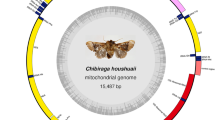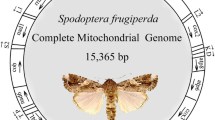Abstract
The 15,338-bp long complete mitochondrial genome (mitogenome) of the Japanese oak silkmoth, Antheraea yamamai (Lepidoptera: Saturniidae) was determined. This genome has a gene arrangement identical to those of all other sequenced lepidopteran insects, but differs from the most common type, as the result of the movement of tRNAMet to a position 5′-upstream of tRNAIle. No typical start codon of the A. yamamai COI gene is available. Instead, a tetranucleotide, TTAG, which is found at the beginning context of all sequenced lepidopteran insects was tentatively designated as the start codon for A. yamamai COI gene. Three of the 13 protein-coding genes (PCGs) harbor the incomplete termination codon, T or TA. All tRNAs formed stable stem-and-loop structures, with the exception of tRNASer(AGN), the DHU arm of which formed a simple loop as has been observed in many other metazoan mt tRNASer(AGN). The 334-bp long A + T-rich region is noteworthy in that it harbors tRNA-like structures, as has also been seen in the A + T-rich regions of other insect mitogenomes. Phylogenetic analyses of the available species of Bombycoidea, Pyraloidea, and Tortricidea bolstered the current morphology-based hypothesis that Bombycoidea and Pyraloidea are monophyletic (Obtectomera). As has been previously suggested, Bombycidae (Bombyx mori and B. mandarina) and Saturniidae (A. yamamai and Caligula boisduvalii) formed a reciprocal monophyletic group.





Similar content being viewed by others
References
Tuskes PM, Tuttle JP, Collins MM (1996) The wild silk moths of North America. Cornell University Press, New York
Park KT, Kim SS, Tshistjakov YA, Kwon YD (1999) Insects of korea series 4. Illustrated catalogue of moths in Korea (i) (sphingidae, bombicoidea, notodontidae). Jeonghaengsa, Seoul
Yoon HY, Kang PD, Kim SE, Lee SM (2006) Breeding of major characteristics of the wild silkmoth, Antheraea yamamai indoor-and outdoor-reared. Korean J Sericult Sci 48:61–67
Arunkumar KP, Metta M, Nagaraju J (2006) Molecular phylogeny of silk moths reveals the origin of domesticated silk moth, Bombyx mori from Chinese Bombyx mandarina and paternal inheritance of Antheraea proylei mitochondrial DNA. Mol Phylogenet Evol 40:419–427. doi:10.1016/j.ympev.2006.02.023
Wolstenholme DR (1992) Animal mitochondrial DNA: structure and evolution. Int Rev Cytol 141:173–216. doi:10.1016/S0074-7696(08)62066-5
Fauron CMR, Wolstenholme DR (1980) Extensive diversity among Drosophila species with respect to nucleotide sequences within the adenine + thymine-rich region of mitochondrial DNA molecules. Nucleic Acids Res 8:2439–2452. doi:10.1093/nar/8.11.2439
Yukuhiro K, Sezutsu H, Itoh M, Shimizu K, Banno Y (2002) Significant levels of sequence divergence and gene rearrangements have occurred between the mitochondrial genomes of the wild mulberry silkmoth, Bombyx mandarina, and its close relative, the domesticated silkmoth, Bombyx mori. Mol Biol Evol 19:1385–1389
Hong MY, Lee EM, Jo YH, Park HC, Kim SR, Hwang JS, Jin BR, Kang PD, Kim K-G, Han YS, Kim I (2008) Complete nucleotide sequence and organization of the mitogenome of the silk moth Caligula boisduvalii (Lepidoptera: Saturniidae) and comparison with other lepidopteran insects. Gene 413:49–57. doi:10.1016/j.gene.2008.01.019
Cameron SL, Whiting MF (2008) The complete mitochondrial genome of the tobacco hornworm, Manduca sexta (Insecta: Lepidoptera: Sphingidae), and an examination of mitochondrial gene variability within butterflies and moths. Gene 408:112–113. doi:10.1016/j.gene.2007.10.023
Kim I, Lee EM, Seol KY, Yun EY, Lee YB, Hwang JS, Jin BR (2006) The mitochondrial genome of the Korean hairstreak, Coreana raphaelis (Lepidoptera: Lycaenidae). Insect Mol Biol 15:217–225. doi:10.1111/j.1365-2583.2006.00630.x
Lee ES, Shin KS, Kim MS, Park H, Cho S, Kim CB (2006) The mitochondrial genome of the smaller tea tortix Adoxophyes honmai (Lepidoptera: Tortricidae). Gene 373:52–57. doi:10.1016/j.gene.2006.01.003
Coates BS, Sumerford DV, Hellmich RL, Lewis LC (2005) Partial mitochondrial genome sequences of Ostrinia nubilalis and Ostrinia furnicalis. Int J Biol Sci 1:13–18
Thompson JD, Gibson TJ, Plewniak F, Jeanmougin F, Higgins DG (1997) The CLUSTAL X windows interface: flexible strategies for multiple sequence alignment aided by quality analysis tools. Nucleic Acids Res 24:173–216
Brodsky LI, Vasiliev AV, Kalaidzidis YL, Osipov YS, Tatuzov ARL, Feranchuk SI (1992) GeneBee: the program package for biopolymer structure analysis. Dimacs 8:127–139
Clary DO, Wolstenholme DR (1985) The mitochondrial DNA molecule of Drosophila yakuba: nucleotide sequence, gene organization, and genetic code. J Mol Evol 22:252–271. doi:10.1007/BF02099755
Beard CB, Mills D, Collins FH (1993) The mitochondrial genome of the mosquito Anopheles gambiae: DNA sequence, genome organization, and comparisons with mitochondrial sequences of other insects. Insect Mol Biol 2:103–124. doi:10.1111/j.1365-2583.1993.tb00131.x
Wernersson R, Pedersen AG (2003) Multiple alignment of coding DNA from aligned amino acid sequences. Nucleic Acids Res 31:3537–3539. doi:10.1093/nar/gkg609
Castresana J (2000) Selection of conserved blocks from multiple alignments for their use in phylogenetic tool. Curr Opin Genet Dev 8:668–674
Schmidt HA, Strimmer K, von Haeseler A (2002) TREE-PUZZLE: maximum likelihood phylogenetic analysis using quartets and parallel computing. Bioinformatics 18:502–504. doi:10.1093/bioinformatics/18.3.502
Akaike H (1974) A new look at the statistical model identification. IEEE Trans Automat Contr 19:716–723. doi:10.1109/TAC.1974.1100705
Abascal F, Zardoya R, Posada D (2005) ProTest: selection of best-fit models of protein evolution. Bioinformatics 21:2104–2105. doi:10.1093/bioinformatics/bti263
Posada D, Crandal KA (1998) Modeltest: testing the model of DNA substitution. Bioinformatics 14:817–818. doi:10.1093/bioinformatics/14.9.817
Adachi J, Hasegawa M (1996) Model of amino acid substitution in proteins encoded by mitochondrial DNA. J Mol Evol 42:459–468. doi:10.1007/BF02498640
Abascal F, Posada D, Zardoya R (2007) MtArt: a new model of amino acid replacement for arthropoda. Mol Biol Evol 24:1–5. doi:10.1093/molbev/msl136
Lanave C, Preparata G, Saccone C, Serio G (1984) A new method for calculating evolutionary substitution rates. J Mol Evol 20:86–93. doi:10.1007/BF02101990
Huelsenbeck JP, Ronquist F (2001) MrBayes: bayesian inference of phylogeny. Bioinformatics 17:754–755. doi:10.1093/bioinformatics/17.8.754
Guindon S, Lethiec F, Duroux P, Gascuel O (2005) PHYML: online—a web server for fast maximum likelihood-based phylogenetic inference. Nucleic Acids Res 33:W557–W559. doi:10.1093/nar/gki352
Swofford DL (2002) PAUP*. Phylogenetic analysis using parsimony (*and other methods) ver 4.10. Sinauer Associates, Sunderland
Felsenstein J (1985) Confidence limits on phylogenies: an approach using the bootstrap. Evol Int J Org Evol 39:783–791. doi:10.2307/2408678
Boore JL (1999) Animal mitochondrial genomes. Nucleic Acids Res 27:1767–1780. doi:10.1093/nar/27.8.1767
Boore JL, Lavrov D, Brown WM (1998) Gene translocation links insects and crustaceans. Nature 393:667–668. doi:10.1038/33577
Anderson S, Bankier AT, Barrell BG, de Bruijin MHL, Droujn ARJ, Eperon IC, Nierlich DP, Roe BA, Sanger F, Schreier PH, Smith AJH, Staden R, Young IG (1981) Sequence and organization of the human mitochondrial genome. Nature 290:457–465. doi:10.1038/290457a0
Ojala D, Montoya J, Attardi G (1981) tRNA punctuation model of RNA processing in human mitochondria. Nature 290:470–474. doi:10.1038/290470a0
Zhang DX, Hewitt GM (1997) Insect mitochondrial control region: a review of its structure, evolution and usefulness in evolutionary studies. Biochem Syst Ecol 25:99–120. doi:10.1016/S0305-1978(96)00042-7
Saito S, Tamuea K, Aotsuka T (2005) Replication origin of mitochondrial DNA in insects. Genetics 171:433–448. doi:10.1534/genetics.105.046243
Clary DO, Wolstenholme DR (1987) Drosophila mitochondrial DNA: Conserved sequences in the A + T-rich region and supporting evidence for a secondary structure model of the small ribosomal RNA. J Mol Evol 25:116–125. doi:10.1007/BF02101753
Zhang D, Szymura JM, Hewitt GM (1995) Evolution and structural conservation of the control region of insect mitochondrial DNA. J Mol Evol 40:382–391. doi:10.1007/BF00164024
Schultheis AS, Weigt LA, Hendricks AC (2002) Arrangement and structural conservation of the mitochondrial control region of two species of Plecoptera: utility of tandem repeat-containing regions in studies of population genetics and evolutionary history. Insect Mol Biol 11:605–610. doi:10.1046/j.1365-2583.2002.00371.x
Crozier RH, Crozier YC (1993) The mitochondrial genome of the honeybee Apis mellifera: complete sequence and genome organization. Genetics 133:97–117
Cha SY, Yoon HJ, Lee EM, Yoon MH, Hwang JS, Jin BR, Han YS, Kim I (2007) The complete nucleotide sequence and gene organization of the mitochondrial genome of the bumblebee, Bombus ignitus (Hymenoptera: Apidae). Gene 392:206–220. doi:10.1016/j.gene.2006.12.031
Cantatore P, Gadaleta MN, Roberti M, Saccone C, Wilson AC (1987) Duplication and remodeling of tRNA genes during the evolutionary rearrangement of mitochondrial genomes. Nature 329:853–855. doi:10.1038/329853a0
Minet J (1991) Tentative reconstruction of the ditrysian phylogeny (Lepidoptera: Glossata). Entomol Scand 22:69–95
Hwang JS, Lee JS, Goo TW, Yun EY, Sohn HR, Kim HR, Kwon OY (1999) Molecular genetic relationships between Bombycidae and Saturniidae based on the mitochondria DNA encoding of large and small rRNA. Genet Anal 15:223–228
Acknowledgments
This work was supported by a grant (code 20070401034004) from the Biogreen 21 Program, Rural Development Administration, Republic of Korea.
Author information
Authors and Affiliations
Corresponding author
Rights and permissions
About this article
Cite this article
Kim, S.R., Kim, M.I., Hong, M.Y. et al. The complete mitogenome sequence of the Japanese oak silkmoth, Antheraea yamamai (Lepidoptera: Saturniidae). Mol Biol Rep 36, 1871–1880 (2009). https://doi.org/10.1007/s11033-008-9393-2
Received:
Accepted:
Published:
Issue Date:
DOI: https://doi.org/10.1007/s11033-008-9393-2




